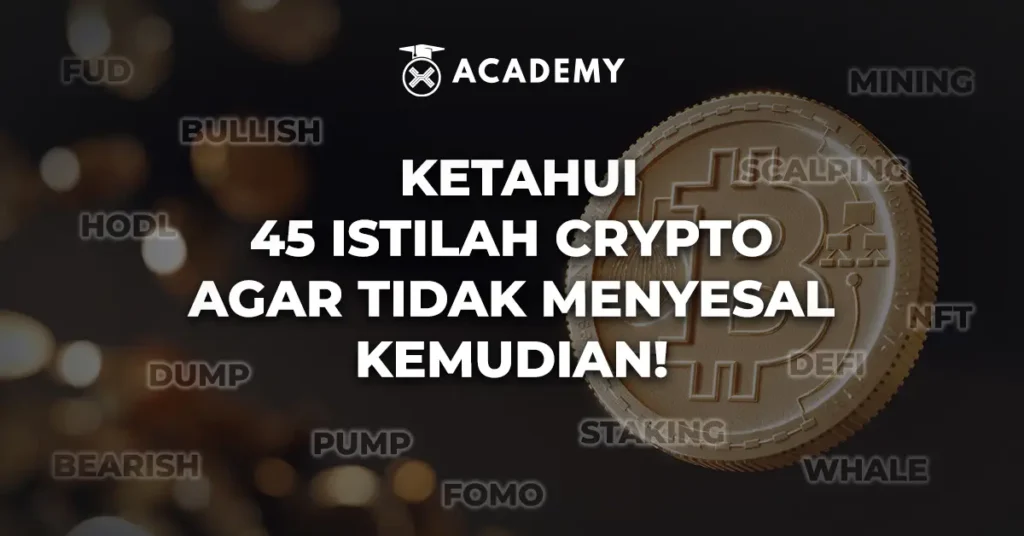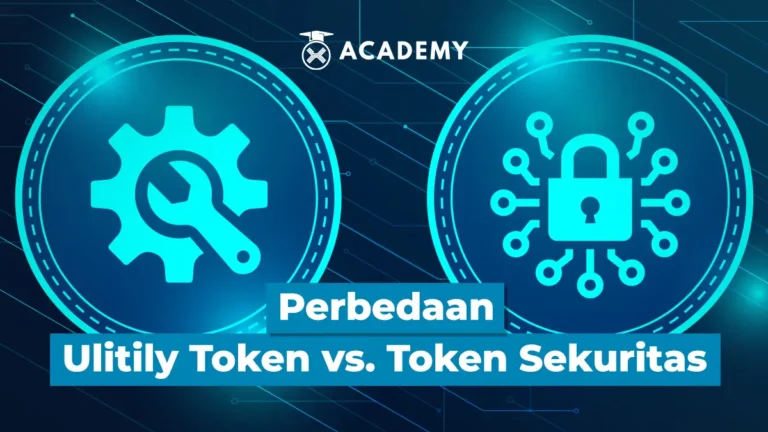The world of crypto trading has a variety of terms that can be confusing, especially for beginners. However, it’s important to understand for anyone looking to get involved in crypto trading.
Understanding the terms is an important step towards easing the trading process in the future.
They are similar to features in an app that must be understood to make informed decisions and protect oneself from scams.
To better understand crypto terms, the impact of not understanding them, and strategies to understand them, check out the full review below.
Why Is It Important to Understand Crypto Terms?
Understanding various crypto terms is important for traders and investors for the following two reasons, among others:
1. Preventing Investment Mistakes
Understanding crypto terms is an important step towards avoiding costly investment mistakes.
Without adequate understanding, investors will likely make poor or wrong decisions when buying, selling, or trading crypto assets.
2. Minimizing Risk
Being knowledgeable about crypto terms can help to minimize investment risk. By understanding market volatility, liquidity, and portfolio diversification, investors can manage risk more effectively.
45 Crypto Terms Beginners Should Know

Looking to invest in crypto? Get to know these 45 terms first so you don’t regret it later, which are as follows:
1. HODL
First on this list is the term HODL, an anagram of “Hold.” This term in the crypto trading stands for “Hold On for Dear Life”.
HODL refers to a trading strategy where investors hold or maintain the crypto assets they own because they believe they have good prospects in the future.
If there is advice from traders or investors to do HODL, it is advisable to hold on to a crypto asset for a certain period.
2. Altcoin
Altcoin refers to crypto coins that were launched after the success of Bitcoin. Coins classified as Altcoins are generally expected to have promising prospects and thus have the potential to experience significant price increases.
Therefore, Altcoins can be an attractive option for those looking for crypto assets other than Bitcoin.
3. Whale
One of the most important terms in crypto trading is “whale.” Capital market investors often use this term to refer to investors who own many crypto assets.
Whales are described as investors who have a significant influence in determining the price of assets in the market due to the large amount of funds they invest.
4. To the Moon
The term “to the moon” has become common among crypto asset investors and traders. This term refers to a situation where the price of a crypto asset experiences a significant increase until it reaches its highest point.
The increase can occur in terms of the value or price of the asset and the number of sales. The term “to the moon” first appeared and became known on specialized forums such as Reddit that discuss topics related to crypto assets.
As knowledge about crypto assets expands, the term “to the moon” is often used to describe crypto assets that have experienced significant price increases by traders and investors.
5. Cryptosis
Cryptosis refers to someone eager to learn all the information about crypto. Usually, this is triggered by a high enthusiasm for owning crypto assets.
In this phenomenon, a person will continue to search and absorb all information about crypto assets until they finally decide to invest.
6. Fiat Currency
Fiat is a term that refers to currencies issued by governments, such as the US dollar or the Japanese yen. More generally, fiat is used to refer to any currency controlled by a central authority.
Meanwhile, Bitcoin, with its decentralized design, serves as a contrast to traditional fiat currencies.
7. Exchange
Exchanges can be physical locations where traders meet to make transactions or electronic platforms that facilitate trading.
They may also be known as stock exchanges or “bourses,” depending on the geography. These exchanges are spread across many countries around the world.
8. Wallet
Crypto Wallets function similarly to physical wallets as a place to store tokens.
However, not all crypto wallets are the same. Hot wallets are online and allow easy access to crypto tokens, but they are also more vulnerable to hacker attacks.
Meanwhile, cold wallets store digital assets offline and make them safer from security threats but make it difficult to perform transactions.
9. Public Key
Public Key is part of the asymmetric cryptography system used in blockchain and crypto technology. It is the key used to encrypt messages or transactions and verify digital signatures.
The Public Key can be accessed by anyone because, as the name suggests, it is public information that is open for viewing. However, despite being freely accessible, only the owner of the corresponding private key can properly perform transactions or sign messages.
10. Private Key
Private key is confidential information only the owner of a crypto wallet, also known as a wallet, has. This private key is a password for your crypto wallet and must be kept confidential.
The important thing to understand is that if someone gains access to your private key, they will have control over all the crypto assets stored in that wallet.
Therefore, it is important to keep your private key safe and confidential to protect the security and privacy of your crypto assets.
11. Mining
One of the next crypto trading terms to know is mining. Mining is an activity where miners use specialized computer devices connected to the internet to solve mathematical complexities.
The purpose of mining is to obtain valuable crypto assets. One crypto asset often mined is Bitcoin or Ethereum because it has a high value.
12. Proof of Work
Proof of Work (PoW) is a consensus algorithm used in crypto networks to verify and secure transactions and reach an agreement on the latest state of a distributed ledger, called a blockchain.
13. Proof of Stake
Proof of Stake (PoS) is a consensus mechanism in blockchain systems where holders of certain crypto assets (usually in the form of coins or tokens) can validate transactions and create new blocks in the network by staking a certain amount of their crypto assets as collateral or “stake”.
14. Smart Contract
Smart contract is an automated contract that runs on top of the blockchain system, where the rules are implemented directly in computer code, and approved by the nodes in the blockchain network.
With the presence of this innovation, any transaction involving blockchain technology will have a high degree of accuracy and be controlled in a transparent, autonomous, and permanent manner. Moreover, this code is distributed in a decentralized manner across the network.
15. Decentralized Finance (DeFi)
DeFi stands for Decentralized Finance, which is a movement within the crypto world that not only focuses on decentralized currency trading, but also doing it in a decentralized way.
One of the most popular examples of DeFi projects is the decentralized exchange protocol, which allows for crypto exchange between buyers and sellers automatically, without the need to go through an intermediary.
16. Non-Fungible Token (NFT)
NFT, short for Non-Fungible Token, is a digital asset that grants ownership of virtual goods, such as digital artwork or online collections.
Most cryptocurrencies are “fungible”, meaning there is no significant difference between one coin and another. Bitcoin holders generally do not pay attention to the specific Bitcoin they own.
On the other hand, holders of Lebron James-themed NFTs, for example, may not place the same value on Kobe Bryant-themed NFTs. NFTs gained great popularity in 2021, culminating in a $69 million NFT digital art auction.
17. Stablecoin
Stablecoin is a blockchain-based crypto or token whose value is tied to another source of value, often a fiat currency. For example, one stablecoin tied to the US dollar is equivalent to $1.
Stablecoins are commonly used to facilitate crypto trading and cross-border financial transactions.
18. Hard Fork
Hard fork is a modification in the crypto asset’s protocol that is out of sync with the previous version. This means that nodes that are not updated to the new version will not be able to process transactions or add new blocks to the blockchain.
Hard forks can be used to change or improve existing protocols, or even to create new, independent protocols and blockchains.
It can also be considered an event when a crypto asset’s development team agrees to implement new features or changes to the coin’s programming system.
19. Soft Fork
Soft fork is a change in a crypto protocol that introduces a new system, but also remains compatible with the previous system as long as it does not violate the rules of the new protocol.
Soft forks occur when most miners update the system and use the new rules. This is in contrast to a hard fork, which requires all nodes to update and agree to the new version.
20. Fork
A fork occurs when a crypto or blockchain-based network branches into two different projects with different code and governing principles.
Unlike a soft fork, where only one blockchain remains active, a hard fork results in two separate block chains.
For example, Bitcoin Classic is a hard fork of Bitcoin. Both cryptos operate on standalone block chains, with separate groups of miners, nodes, and network participants.
21. Airdrop
Airdrop is a marketing strategy that involves the free distribution of tokens or coins to holders of specific crypto wallet addresses.
The purpose of a crypto airdrop is to promote their tokens or coins to the general public in hopes of increasing awareness, interest, and adoption of the crypto project.
22. Gas Fee
Gas Fees are fees paid by users to execute transactions on the blockchain network. In the context of Ethereum, a gas fee is a fee paid in Ether (ETH) to execute a transaction or smart contract on the Ethereum network.
The gas fee is compensation for miners who validate and process the transaction.
23. Gas Price
Gas Price is the price set by users to pay transaction fees on the blockchain network. On the Ethereum network, gas prices are expressed in Ether (ETH) units and are used to determine total transaction costs in the form of gas fees.
Please note, the higher the gas price set by the user, the higher the transaction priority for processing by miners on the Ethereum network.
24. Gas Limit
Gas Limit is the maximum limit on the amount of gas that a user is ready to pay to execute a transaction on the blockchain network.
Every transaction on a blockchain network requires gas to execute and the gas limit determines the maximum amount of gas that can be used for one particular transaction.
If the gas limit set is too low then the transaction may not be executed successfully because there is not enough gas to complete the requested operation.
On the other hand, if the gas limit is too high then the user may pay more than they should for the transaction.
25. Hardware Wallet
Hardware Wallet is a physical device specifically designed to store and manage crypto assets such as Bitcoin and Ethereum with maximum security.
Unlike software wallets that store data on a computer or mobile device, this device stores private keys and crypto assets directly on it.
Hardware wallets are often referred to as “cold wallets” because they are not connected directly to the internet. This makes it safer from online threats compared to “hot wallets” or online wallets.
Typically, these devices are small and portable, and can connect to a computer or mobile device via a USB or Bluetooth connection.
26. Cold Storage
Cold storage is a storage method used to store digital assets offline, separate from the internet.
The main purpose of cold storage is to increase security, especially when storing large amounts of digital assets. Cold storage is generally implemented through paper wallets and hardware wallets.
27. Hot Wallet
Hot Wallet is a type of crypto wallet that is actively connected to the internet or blockchain network. It allows users to quickly access and carry out transactions with their crypto assets.
Examples of hot wallets are online wallets, mobile wallets, or wallets connected to crypto exchanges.
Because they are connected online, hot wallets tend to be more vulnerable to cyber attacks compared to cold wallets, which are wallets that are stored offline.
28. Market Capitalization
Market Capitalization is a measure of the total value of a crypto assets traded on the market. This is calculated by multiplying the amount of crypto assets in circulation by the current price of that crypto asset.
Market capitalization provides an overview of the relative size of a crypto asset in the market, thereby helping investors understand how large the crypto asset is in the context of the market as a whole.
In this case, the higher the market capitalization of a crypto, the greater the total value of the asset in the crypto market.
29. Liquidity
Liquidity refers to the ability of an asset to be bought or sold without significantly affecting the market price.
This concept also includes how easily an asset can be exchanged for fiat currency. Assets that are difficult to convert into cash are considered illiquid, while assets that can be easily exchanged are considered liquid.
30. Volume
Volume refers to the number of crypto units traded in a certain time period on the market. This includes all purchases and sales that occurred within that time period.
Volume provides an overview of trading activity in the market and can be used to measure investor interest in a crypto asset.
The higher the trading volume, the higher the market activity, which can reflect the greater interest and trust of market participants in the crypto assets.
31. Market Dominance
Market dominance refers to the ability of a crypto asset to control or influence the market compared to other cryptocurrencies.
Market dominance is usually measured as the percentage of the total overall crypto market capitalization owned by a particular crypto asset.
32. Market Share
Market share is the part or percentage of the market controlled by a particular crypto or crypto asset in the context of the crypto market as a whole.
Market share is a relative measure of the dominance or presence of a crypto asset in the market compared to other cryptocurrencies.
33. Market Cap
Market Cap or market capitalization is the total value of all crypto on the market at a certain time. Market Cap is calculated by multiplying the number of coins in circulation by the current market price of the crypto assets.
Market Cap provides an overview of the overall size of the crypto market and how much the total value of all crypto in circulation is.
Market Cap is also used to compare the relative value of various cryptocurrencies in the market and to evaluate the overall market size and growth. Market Cap is often considered an important indicator in analyzing and understanding the crypto market.
34. Circulating Supply
Circulating Supply is the total amount of crypto currently available and tradable on the market.
Circulating Supply includes all coins or tokens that have been issued and are circulating among the public, excluding coins or tokens that are blocked, held by the project team, or cannot be traded.
35. Total Supply
Total supply refers to the total number of coins or tokens ever created in a crypto blockchain protocol. This includes all coins that are in circulation (circulating supply) and also those that are still stored.
Total supply indicates the maximum number of tokens that can be produced on a particular blockchain platform. This amount is generally set by the developer from the start of the crypto asset project’s creation and is described in the whitepaper.
The total supply cannot be changed after the presale or Initial Coin Offering (ICO) stage except through contract modification.
36. Tokenomics
Tokenomics refers to the economic design and incentive model behind a crypto asset or blockchain project. This includes token distribution, token utility, token supply, token inflation/deflation, as well as incentives and economic models.
Tokenomics describes how crypto assets or blockchain projects are designed and distributed to create a sustainable economic model. Good tokenomics design is critical to the long-term adoption and sustainability of blockchain projects.
37. Utility Token
Utility tokens are a type of crypto designed to be used as a means of payment or access within a particular ecosystem or platform.
In contrast to other crypto assets which may have intrinsic value or other functions outside their ecosystem, utility tokens have value because they can be exchanged for goods or services within the platform or ecosystem that supports them.
38. Governance Token
Governance tokens are a type of crypto that gives their holders the right to participate in decision making regarding a particular blockchain system or protocol.
By owning a governance token, the holder has voting rights or the authority to influence changes or improvements in the protocol.
39. Liquidity Mining
Liquidity mining is a process in which individuals or entities provide liquidity for certain crypto pairs on an exchange platform or decentralized finance (DeFi) protocol in exchange for crypto tokens.
In liquidity mining, participants lend their crypto assets into a liquidity pool thereby allowing other users to trade easily.
As a reward, participants receive new tokens as a gift or compensation for their contribution to market liquidity.
40. Yield Farming
Yield farming is a strategy in the DeFi (Decentralized Finance) ecosystem where users utilize various financial services and products to optimize income from their crypto assets.
In yield farming, users put their crypto into various DeFi protocols, such as liquidity pools, lending platforms, or decentralized exchanges (DEX), with the aim of getting a higher rate of return than they would get elsewhere.
41. Staking
Staking refers to the process of participating in a Proof of Stake (PoS) consensus mechanism. When we lock up the crypto we own to support the network, it is called staking. However, users can still release it if they want to exchange it.
42. Impermanent Loss
Impermanent loss is a temporary loss that a liquidity provider may experience when weighing two crypto assets in a liquidity pool. This loss occurs due to the difference between the price of the asset in the liquidity pool and the price of the asset in the market.
As prices change, liquidity providers may experience these temporary losses when withdrawing their assets from liquidity pools.
43. APY
APY or Annual Percentage Yield is the rate of return or interest earned by investors on their investments in a certain period of time which is usually measured annually.
The APY includes the net return from interest rates paid as well as possible growth in asset value. It provides a comprehensive picture of the potential return on an investment over a certain period of time.
44. Obsess
Obsessive Crypto Disorder (OCD) is a term used to describe a mental health disorder in which a person feels constantly tied to compulsively checking crypto prices, news and trading volumes.
It can disrupt an individual’s daily life and cause significant anxiety related to crypto market activity.
45. Zero Confirmation
Zero Confirmation is a term that refers to Bitcoin transactions or other crypto assets that the blockchain network has not processed. This transaction has not been included in the block and has not been verified by miners.
As a result, Zero Confirmations are not yet considered valid and can be re-recorded or canceled before being included in the blockchain block.
While Zero Confirmation can provide an early indication of transaction activity, it inherently carries additional security risks because they have not been confirmed by the blockchain network.
The Impact of Not Understanding Crypto Terms

It’s important to remember that not understanding crypto terms can have a significant impact on investors. The following are some of the impacts you need to know, including:
1. Potential Regret
Basically, a lack of understanding of crypto terms can result in regrets in the future because it can lead to inappropriate or risky decisions.
Without adequate understanding, a person may not be fully aware of the risks and consequences of their actions in crypto investments. This can lead to regret when the results do not match expectations or when losses occur that could have been avoided.
2. Case Study
For example, someone who does not understand crypto terms such as “volatility,” “stop-loss,” or “wallet” is likely to experience major financial losses. Maybe they don’t understand the importance of managing risk or using protective strategies such as stop-losses in their trading.
In other situations, a lack of understanding of how to safely store crypto in the right wallet can also result in loss of access to their digital assets due to theft or loss of private keys.
Strategy for Understanding Crypto Terms
To understand crypto terms, there are several strategies that investors can apply, including:
1. Training and Education
Continuous training and education are important strategies in understanding the world of crypto better. Given that the crypto industry is constantly evolving and changing, it is important for individuals to stay current.
By continuing to learn, whether through online courses, webinars, seminars, or reading the latest literature, one can gain a deeper understanding of crypto terms and how they operate in the blockchain ecosystem.
2. Available Resources
In fact, there are many resources and online platforms available to help individuals learn crypto terms.
Some of these include online crypto dictionaries, crypto education websites, discussion forums, and social media channels dedicated to crypto topics.
Conclusion
In conclusion, understanding crypto terms is an important step before diving into the world of crypto investment.
With a strong understanding of the basic concepts and terms used in this industry, one can make better investment decisions and minimize the risk of loss.
Through a deep understanding of various terms and concepts, investors can identify opportunities, avoid costly mistakes, and maximize their profit potential.
Furthermore, it is important for readers to take concrete steps to deepen their understanding of the crypto world before starting to invest.
In this case, training, education, and active exploration of available resources can help build a strong foundation of knowledge and prepare oneself for success in the dynamic crypto market.
So, now you understand what crypto terms are, the impact of not understanding them, and strategies for understanding them.
Furthermore, you can read the most complete dictionary on all crypto exchanges in the Indonesian market only in the collection of crypto term dictionaries on INDODAX Academy.
For information, if you are interested in deepening your knowledge regarding blockchain technology, it would be a good idea for you to explore the various articles on INDODAX Academy.
Please note, INDODAX Academy presents various materials related to blockchain and crypto assets, starting from basic concepts to the application of this technology.
Through the articles available on INDODAX Academy, you will be able to gain more in-depth knowledge regarding blockchain technology and crypto assets.
So, let’s increase your understanding of the world of blockchain and crypto assets with INDODAX Academy!








